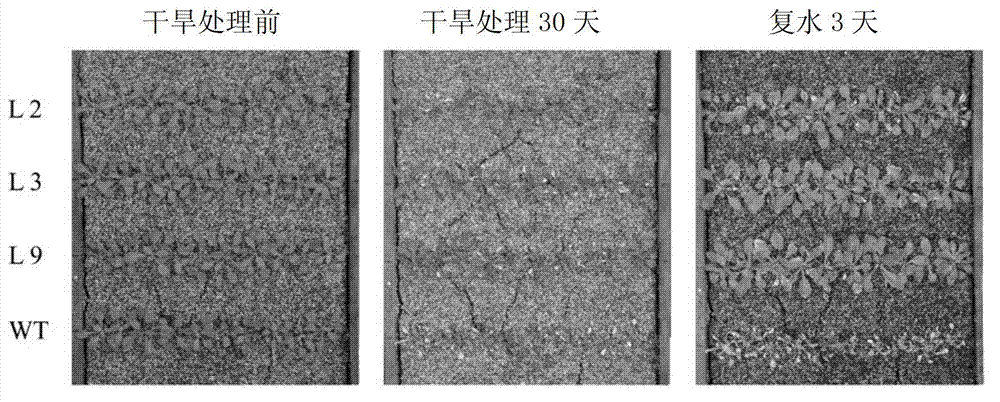Plant adversity-resistant related protein TaMYB30, coding gene and application thereof
A plant stress tolerance and coding technology, which is applied to the plant stress tolerance-related protein TaMYB30 and its coding gene and application field, can solve the problems of complex stress resistance mechanism of plants, achieve broad application and market prospects, and improve the effect of stress tolerance
- Summary
- Abstract
- Description
- Claims
- Application Information
AI Technical Summary
Problems solved by technology
Method used
Image
Examples
Embodiment 1
[0039] Embodiment 1, discovery of TaMYB30 protein and its coding gene
[0040] In order to study the function of wheat MYB gene in plant stress resistance, 60 genes encoding wheat MYB protein were screened from 30,000 non-redundant wheat full-length cDNA sequences sequenced in the laboratory by bioinformatics method. The expression patterns of 60 wheat MYB genes under stress conditions were studied by semi-quantitative PCR, and the genes induced by stress were screened out.
[0041] The protein shown in Sequence 1 of the sequence listing is named TaMYB30 protein, which consists of 732 amino acid residues. The gene encoding the TaMYB30 protein is named TaMYB30 gene, its open reading frame is shown in the sequence 2 of the sequence listing from the 162-2357th nucleotide at the 5' end (2196bp), and its full-length cDNA is shown in the sequence 2 of the sequence listing Its genomic DNA is shown in sequence 3 of the sequence listing.
Embodiment 2
[0042] Example 2, the expression pattern of TaMYB30 gene in different tissues and the expression pattern under drought stress conditions
[0043] 1. Expression pattern of TaMYB30 gene in different tissues
[0044] RNA was extracted from different tissues (roots, stems, leaves, pistils, anthers) of Chinese spring wheat at the flowering stage, and the expression level of TaMYB30 gene was detected by RT-PCR. The target fragment of RT-PCR was 271bp, and the primers used were as follows:
[0045] Upstream primer: 5'-TGTTGATCCCTATGAGAATG-3';
[0046] Downstream primer: 5'-AGCTTGAGCTGCATGAGTA-3'.
[0047] The expression patterns of TaMYB30 gene in different tissues are shown in figure 1 , are expressed in various tissues.
[0048] 2. Expression pattern of TaMYB30 gene under drought stress conditions
[0049] Chinese spring wheat at the two-leaf one-heart stage was treated with 16.1% PEG aqueous solution; the leaves were taken before (0h), 1 hour after treatment, 3 hours after tre...
Embodiment 3
[0053] Embodiment 3, the acquisition of transgenic plants and the identification of stress tolerance
[0054] 1. Using Gateway technology to construct overexpression vectors
[0055] 1. attB primer design
[0056] Primer Primer5.0 software was used to design primers for amplifying the coding region of TaMYB30 gene. According to the requirements of Gateway technology for constructing expression vectors, attB1 and attB2 recombination sites were added to the 5' ends of the upstream primer (F1) and downstream primer (R1), respectively. The designed primer sequences are as follows:
[0057] F1: 5'- GGGGACAAGTTTGTACAAAAAAGCAGGCT GGATGGCGACCGGCCCCGAT-3';
[0058] R1: 5'- GGGGACCACTTTGTACAAGAAAGCTGGGT TCAAAGGCTATTAAGAAGA-3'.
[0059] In the upstream primer, the attB1 recombination site is underlined. In the downstream primers, the attB2 recombination site is underlined.
[0060] 2. Extract the total RNA of Chinese spring wheat and reverse transcribe it into cDNA.
[0061] 3....
PUM
 Login to View More
Login to View More Abstract
Description
Claims
Application Information
 Login to View More
Login to View More - Generate Ideas
- Intellectual Property
- Life Sciences
- Materials
- Tech Scout
- Unparalleled Data Quality
- Higher Quality Content
- 60% Fewer Hallucinations
Browse by: Latest US Patents, China's latest patents, Technical Efficacy Thesaurus, Application Domain, Technology Topic, Popular Technical Reports.
© 2025 PatSnap. All rights reserved.Legal|Privacy policy|Modern Slavery Act Transparency Statement|Sitemap|About US| Contact US: help@patsnap.com



